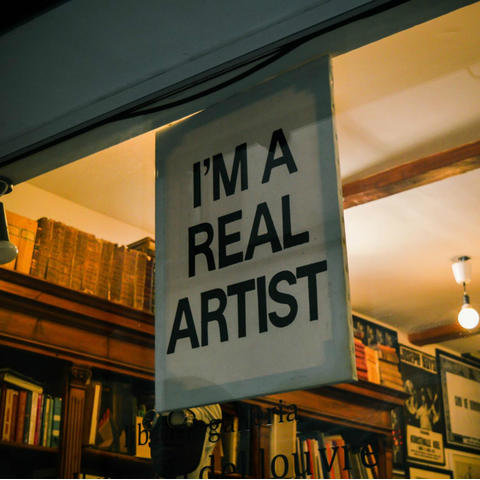
Most freelance work is an exchange of time for money. You charge a certain amount for the hours you put in. As you build a steady client base, you’ll earn enough from your time to pay the bills. It sounds good in theory, but unlike a salaried position, any time you spend working on your business – doing admin, learning new skills, and pursuing passion projects – is unpaid. These necessary tasks eat into the number of billable hours you have per month.
Building your business on an exchange of time for money automatically caps your earnings by the number of hours you can physically work. If you have to decrease your workable hours for any reason, your income decreases as well.
There comes a certain point in your career where you’ll reach the top of the market. Especially in a small creative community like New Zealand, there’s a ceiling on what funding bodies and clients will pay for your work.
As a creative professional, how do you grow your career and improve your financial position?
 Photo by Chris Curry on Unsplash
Photo by Chris Curry on Unsplash
Build your own passive income
I don’t want to sound like a skeezy Multi-Level Marketing salesperson, but here’s the bit where I talk about passive income. This is where you build something creative and awesome – a video, a story, a piece of art – once, and then earn money on it forever (or as long as it’s available). Passive income isn’t tied to the hours you work, and there’s no cap on potential revenue.
In the creative industries, we’re most familiar with passive income in the form of royalties for books, movies, songs, etc. You can expand your definition to include other creative ideas. Over time, these passive income streams can build into a sustainable business that enables you to quit client work altogether and focus on your own creative outlets.
Examples of passive income for creatives:
- Designers creating Photoshop/Instagram filter packs.
- Musicians and sound-designers offering tracks for use in podcasts and video production.
- Photographers building libraries of stock photos, especially on niche subjects. (An example of this would be the stock site Period Images, which offers image sets for romance and fantasy book covers.)
- Artists offering prints and swag with their artwork. You can do this using print-on-demand sites like Printifyor Society6.
- Creatives using platforms like Teachable and Thinkific to build courses, webinars, and guides to teach their discipline to the world.
- Game-designers offering simple and addictive mobile games.
- Writers producing interactive fiction, such as those published by Choice of Games.
- Podcasters and videographers creating and monetizing Youtube channels or launching Patreon accounts.
- Actors narrating audiobooks through Findaway Voices or ACX. These platforms offer up-front fees or royalty share options.
- ?Illustrators collecting black-and-white drawings around certain themes and using Amazon’s KDP Print to create adult colouring books.
I’ve seen the benefits of royalties/passive income in my own life. When I built a freelance career based on client work, my earnings tapped out at around $75k a year. Try as I might I couldn’t crack higher without giving up my precious Netflix and cat-snuggle time.
Instead, I decided to focus on what I was really passionate about – writing fiction. I studied the market, found a niche with a lot of voracious readers that would also satisfy me creatively. I wrote books and self-published them for maximum royalties. The first book I published earned $50 in its first month, mostly from friends and family members. Not exactly diving into a pool of money like Scrouge McDuck.
But I kept publishing, and each book did a little better than the last. Eventually, I had a library of books to satisfy hungry readers and enough passive income that I didn’t need client work anymore. I work fewer hours, the work is great fun, and the extra money provides me with a degree of financial security.
 Photo by Ryoji Iwata on Unsplash
Photo by Ryoji Iwata on Unsplash
A new mindset
Not all creatives are excited by the possibilities of passive income. This model requires you to think like an entrepreneur and see opportunities around you. Entrepreneurs have a growth mindset – they see their business as much bigger than themselves. They’re constantly thinking about how to grow and give more value.
Ask yourself:
- Are you happy with your current business and income level?
- ?Are you feeling stressed by the constant hustle for work?
- Do you enjoy collaborating with clients or do you prefer creating your own work?
- Is your mind bursting with ideas for your own passive income streams?
- Can you see opportunities where you could supply a niche market?
- ?Do you have existing work you can repurpose for passive income?
Once you have a direction, dedicate a few hours a week to producing creative work to grow your passive income. Over time, this dedication will build a portfolio of income-generating work.
Exchanging your time for money is a great way to start your career as a freelancer and build a solid industry reputation. If you want to grow your business and creative practice, consider how you might be able to turn your skills into passive income.
This article was originally published in The Big Idea.


